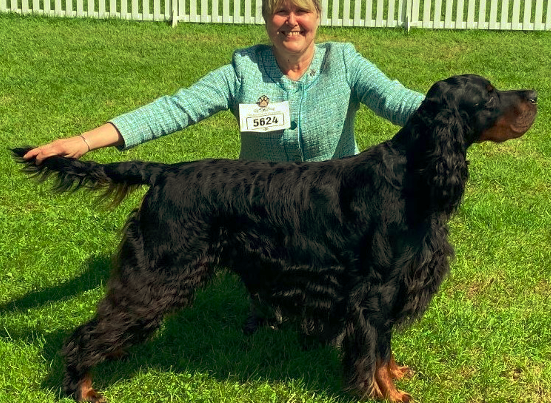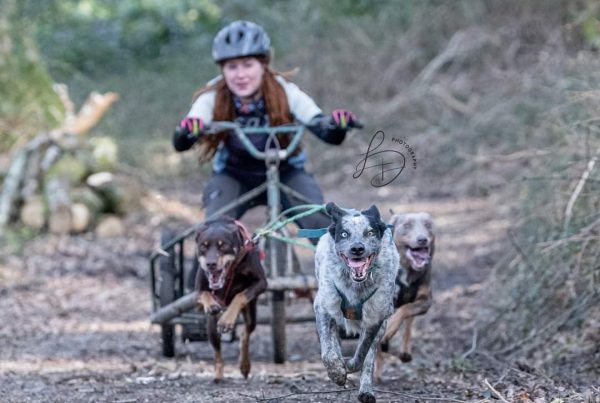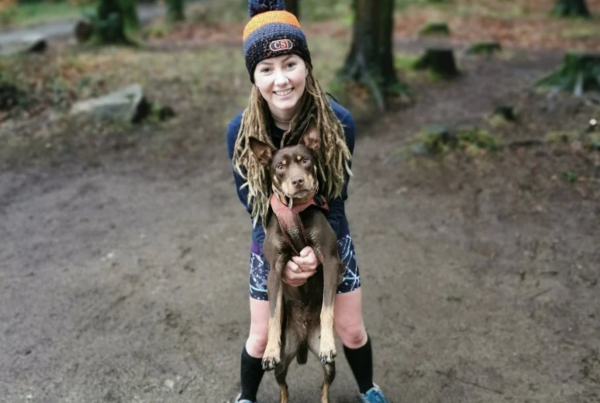Jim Urwin introduces the sport of canicross and tells the story of how German Shorthaired Pointers a re becoming one of the most popular and successful dogs with competitors in the UK
re becoming one of the most popular and successful dogs with competitors in the UK
“Canicross is cross-country racing with your dog. Typically, the runner has a belt, the dog has a harness and the two are connected by a bungee-type lead. If all goes according to plan, the dog helps to pull the runner along at a faster pace than they would normally achieve on their own – extremely exhilarating.
Canicross grew out of sled dog racing where it is seen as a way of helping to keep dogs fit out-of-season. The sport is well-established in mainland Europe: the fifteenth running of the annual European Canicross Championships took place last October. In the UK, canicross only really began as an organised sport,around 6 years ago, but has progressed rapidly since. The season, which runs from the start of September through to mid-May, now includes nearly forty races around the country.
Venues vary, but events are most frequently held in woodland belonging to the Forestry Commission, sometimes in country parks and occasionally on National Trust estates (all usually very nice locations whether you are running or not). There is even a night race and a beach race. Often there are two races at a weekend, on the Saturday and then the Sunday, over the same circuit. Races start at 10am at the latest so that the dogs are running in the coolest of conditions possible.
Races for adults are usually between three and three and half miles long. Conditions, and hence times, can vary considerably: the steepness of the terrain, conditions underfoot and the weather all play a part.
At most events, the races are time-trialled with competitors setting off every ten seconds. There are many different categories. Men and women compete separately and according to age group: in the UK, the categories are up to 40 years old, 40-49 and 50 and over. There is also a race for those wanting to run with two dogs, as well as races over about one and a quarter miles for 7-10 year olds, teenagers and adult newcomers who want to test themselves over a shorter distance. Points are awarded depending on how high up the order you finish, and at the end of the season those with the most points in each age category become the UK National Champion in their category. Courtesy of the sponsors, currently CSJ, each champion receives a year’s worth of free dog food. The dogs have to be over one year old to compete.
Runners and dogs c![582810_4336187648822_110824198_n[2]](https://csjk9blog.files.wordpress.com/2013/06/582810_4336187648822_110824198_n2.jpg?w=300) ome in many different shapes and sizes. This is a sport for all with the emphasis being as much on fun, a bit of exercise and socialising (for humans and dogs alike) as well as the racing itself.
ome in many different shapes and sizes. This is a sport for all with the emphasis being as much on fun, a bit of exercise and socialising (for humans and dogs alike) as well as the racing itself.
I did my first canicross race with our Siberian Husky-German Shepherd cross, Casper, in September 2008. Athletics was never my sport as a youngster, but I have always run to keep fit and could never see the point in going for a run and then afterwards taking the dog out for walk. Combining the two always seemed to me to be the more sensible approach .
When I first started doing canicross events, I just raced with a normal lead to the collar, running side-by-side with Casper, but soon progressed to the canicross kit. The following season (2009/10), at the grand old age of 58, I won the 50+ years old (‘Veteran Male’) National Championship. But by then, my wife, Maggie, and I already had our eyes set on a new recruit.
In October 2009, we had headed off in our camper van to experience our first European Canicross Championships, held that year in Hungary. I was one of a squad of 16 men and women repre senting the UK. The event was a real eye-opener. We expected there to be lots of huskies, and there were. But most of the top European runners had either GSPs or Eurohounds, a mix of GSP and Alaskan Husky, but looking, to our untrained eyes, very GSP-like, albeit up to fifty per cent bigger.
senting the UK. The event was a real eye-opener. We expected there to be lots of huskies, and there were. But most of the top European runners had either GSPs or Eurohounds, a mix of GSP and Alaskan Husky, but looking, to our untrained eyes, very GSP-like, albeit up to fifty per cent bigger.
No sooner had we got home than Maggie, who has supported me endlessly throughout my canicross ‘career’, started doing the research. She learnt that Steve and Bev Beresford’s bitch, Tessie, at Tuptonsett was about to have a litter at Christmas. So two weeks after the arrival of eleven puppies off we went to take a look. To a bemused Steve and Bev, we explained why we wanted a GSP. After some reflection, Steve said, that’s the one you want, pointing to a black and white ball of fur (Tuptonsett Inca), who we were later to name Boris. And how right he was.
Over the following year, throughout 2010, we took Boris along to canicross events as I continued to compete with Casper. He looked, learnt, and became accustomed to the routine, although, if he had his way, he would have joined in from the very first time he saw the racing. As he grew older, I let him run alongside me and Casper on our training runs. The first time I put him in a harness for a test run we ran just half a mile along an uneven bridleway in precisely two and half minutes, way faster than I had ever run with Casper (way, way faster than I could ever run on my own). Maggie and I knew we had a special dog.
The big day arrived at the end of January 2011: Boris’ first race. Come the finish line, I was exhausted – and the timekeepers were disbelieving of the time they had recorded. How could an old man and a young dog run so fast? Any doubts they had about their electronic timing equipment were dispelled the next day when we raced the same course again and recorded virtually the same time. The scene had been set.
Over the next four months until the end of the 2010/11 season, Boris and I won every Veterans race and were invariably amongst the top three, four or five fastest runners of all the age groups. A second National Championship was secured, and then again, last season (the 2011/12 season), with Boris taking over full-time from Casper, a third; and by the time this article is published, fingers crossed, a fourth title will be in the bag well before the last race of the current 2012/13 season has been run (as I write, we have a significant lead in the table). Boris is making up for my aging legs.
It was however in the European Canicross Championships in Poland in October 2011 that Boris really made his mark when we won gold in the ‘Super-Veterans’ (60+ year old) category and became the first ever Brits to be champions of any age group – and then we were lucky enough to do it again last October when the Championships were held in the UK for the first time, at Cirencester Park in Gloucestershire.
We cannot recall a GSP running at a canicross race in the UK until Boris came along. Today, the contrast could not be greater. It is difficult to be precise but it seems to us that just about every other new puppy or dog acquired by regular canicross competitors is a GSP. This comes as no surprise. In addition to the successes I have enjoyed with Boris, we have now seen, amongst others, a UK female competitor win European gold last October at Cirencester Park in the 50-59 years old age group with her GSP, and the UK female teenagers championship won last season by a girl competing with her young GSP. This current season in the UK Championship, the 19-39 years old female category looks set to be won by another runner with a young GSP.
So what makes GSPs so good at canicross? Just what GSP owners would know already: their athleticism, their speed, strength and power, and their sheer enthusiasm. Born to run, born to race is how we often describe Boris. It is no wonder that they are the rising stars of canicross – and they come with the bonus of being such lovely, characterful pets and companions too.
Boris also has one other characteristic that, on the one hand, is a very good thing, but on the other has nearly got us disqualified on several occasions: he is phenomenally competitive, to the extent that he wants to tell dogs we pass who he sees as a threat not to think about coming back and trying to overtake us. A little word in their ear is how I would describe it! We learned belatedly that Boris’ father – Susan and Norris Davison’s Wyatt – has the Kennel Club name, Seek Infront. How apt we thought when we first heard: like father, like son. Then we thought about it some more and decided that slightly more appropriate for Boris would be Seek Infront At All Costs! Maybe it is that edginess in races that makes him an exceptional champion”.
******************************
For more information on canicross and the UK Championship, go to: www.canix.co.uk. To see canicross in action, and to see Jim (and Boris!) interviewed, there’s a very good video of last October’s European Canicross Championships here on our website.
This article first appeared in: GSP Association magazine
LATEST NEWS
- The setting up of the British Sleddog Sports Federation as the umbrella organisation for canicross in GB and Northern Ireland
- How local canicross groups are beginning to set themselves up around the country – with the intention of organising their own races
- How increasingly ‘normal’ cross-country races and fun runs are allowing competitors to run with their dogs


